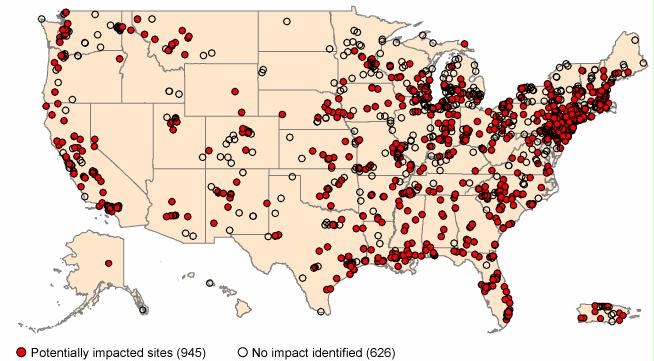
Preface. The energy crisis is likely to strike soon since global peak oil production was reached in November 2018 (EIA 2020). Let’s use energy to clean up these Superfund sites and nuclear waste, rather than wasting energy on wind turbines and solar panels. Time is running out. Over 945 Superfund sites (of 1,315) may be affected by climate change due to floods, wildfires, storm surge, or sea level rise in the future.
In the late 90s, during President Bill Clinton’s second term, the EPA averaged 87 completed cleanups per year; over the first six years of the George W. Bush administration, the number dipped to 40; Obama’s first year in office saw 20 completed clean ups and in 2014 the number dived to a piddly eight. By the tail-end of the Obama years there were still 1,300-plus sites on the Superfund National Priorities List—the worst of the worst—and some 53 million people living within three miles of one. Under Trump, officials deleted seven sites from the Superfund list in 2017, 22 in 2018 and 27 in 2019—the highest single-year total since 2001.Stagnated projects like Butte, Montana’s noxious Berkeley Pit have been reinvigorated and schedules have been accelerated, like at Indiana’s USS Lead site, a former lead ore refinery, and the West Lake Landfill in Missouri. (Ferry 2020).
EPA places sites into the following six broad categories based on the type of activity at the site that led to the release of hazardous material:
- Manufacturing sites include wood preservation and treatment, metal finishing and coating, electronic equipment, and other types of manufacturing facilities.
- Mining sites include mining operations for metals or other substances.
- “Multiple” sites include sites with operations that fall into more than one of EPA’s categories.
- “Other” sites include sites that often have contaminated sediments or groundwater plumes with no identifiable source.
- Recycling sites include recycling operations for batteries, chemicals, and oil recovery.
- Waste management sites include landfills and other types of waste disposal facilities.
Superfund in the news:
2020 Biden will inherit hundreds of toxic waste Superfund sites, with climate threats looming. The EPA’s program for cleaning up the nation’s hazardous waste dumps has a backlog of sites that lack funding — the largest in 15 years.
Alice Friedemann www.energyskeptic.com Women in ecology author of 2021 Life After Fossil Fuels: A Reality Check on Alternative Energy best price here; 2015 When Trucks Stop Running: Energy and the Future of Transportation”, Barriers to Making Algal Biofuels, & “Crunch! Whole Grain Artisan Chips and Crackers”. Podcasts: Crazy Town, Collapse Chronicles, Derrick Jensen, Practical Prepping, KunstlerCast 253, KunstlerCast278, Peak Prosperity
***
GAO. 2019. SUPERFUND. EPA should take additional actions to manage risks from climate change. United States Government Accountability Office.
Climate change may increase the frequency and intensity of certain natural disasters, which could damage Superfund sites—the nation’s most contaminated hazardous waste sites.
Federal data suggests about 60% of Superfund sites overseen by EPA are in areas that may be impacted by wildfires and different types of flooding—natural hazards that may be exacerbated by climate change.
We found that EPA has taken some actions to manage risks at these sites. However, we recommend it provide direction on integrating climate information into site-level decision making to ensure long-term protection of human health and the environment.
*** Notes from the report:
As of September 2019, there were 1,336 active sites on the list, and 421 sites that EPA had determined need no further cleanup action (deleted sites). About 90 percent of these active and deleted NPL sites are nonfederal sites, where EPA generally carries out or oversees the cleanup conducted by one or more potentially responsible parties (PRP). The other NPL sites—approximately 10 percent—are located at federal facilities, and the federal agencies that administer those facilities are responsible for their cleanup.
in a 2007 report, the National Research Council noted that buried contaminated sediments at Superfund sites may be transported during storms or other high-flow events, becoming a source of future exposure and risk.
SEA LEVEL RISE: We identified 110 nonfederal NPL sites—7 percent—located in areas that would be inundated by a sea level rise of 3 feet, based on our analysis of EPA and NOAA data as of March 2019 and September 2018, respectively. Our analysis shows that if sea level in these areas rose by 1 foot, 97 sites would be inundated. If sea level in these areas rose by 8 feet, 158 sites would be inundated. We also identified 84 nonfederal NPL sites that are located in areas that may already be inundated at high tide
In 2017, Hurricane Harvey dumped an unprecedented amount of rainfall over the greater Houston area, damaging several Superfund sites that contain hazardous substances. At one site on the San Jacinto River in Texas, floodwater eroded part of the structure containing such substances, including dioxins, which are highly toxic and can cause cancer and liver and nerve damage
And much more at https://www.gao.gov/assets/710/702158.pdf
References
EIA (2020) International Energy Statistics. Petroleum and other liquids. Data Options. U.S. Energy Information Administration. Select crude oil including lease condensate to see data past 2017.
Ferry D (2020) The One Incredibly Green Thing Donald Trump Has Done. Politico.

2 Responses to 945 U.S. Superfund sites vulnerable to climate change